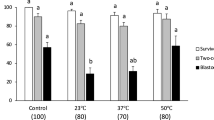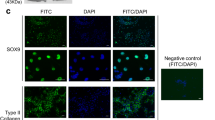Abstract
SINCE the discovery that glycerol will protect cells and tissues against freezing damage1, considerable progress has been made in developing techniques for the preservation of tissues at very low temperatures. Attempts to establish low-temperature banks of adult human cartilage have unfortunately, so far, proved unsuccessful2. Biggers3, however, was able to show that embryonic chick tibiæ will grow and differentiate in vitro, after freezing to −79 ° C., in saline containing 15 per cent glycerol. This communication describes briefly some of the work concerned with freezing embryonic rat tibiæ to −79° C. A fuller account is being given elsewhere4. Rat fœtuses of a known age were obtained from the Medical Research Council strain of albino rat, bred in the Department. The occurrence of a vaginal copulation plug, or the presence of sperm in the vaginal smear, was taken as the indication of mating. On the seventeenth day post coitum, the conceptuses were excised, and the embryonic tibiæ were isolated under a dissecting microscope. The bones were cleaned of as much extraneous tissue as possible, with care to avoid injuring the perichondrium. The structure of these tibiæ is being described elsewhere5.
This is a preview of subscription content, access via your institution
Access options
Subscribe to this journal
Receive 51 print issues and online access
$199.00 per year
only $3.90 per issue
Buy this article
- Purchase on Springer Link
- Instant access to full article PDF
Prices may be subject to local taxes which are calculated during checkout
Similar content being viewed by others
References
Polge, C., Smith, A. U., and Parkes, A. S., Nature, 164, 666 (1949).
Curran, R. C., and Gibson, T., Proc. Roy. Soc., B, 144, 572 (1955).
Biggers, J. D., Experientia, 13, 483 (1957).
Heyner, S., J. Exp. Zool. (in the press).
Biggers, J. D., Gwatkin, R. B. L., and Heyner, S., Exp. Cell. Res. (in the press).
Fell, H. B., and Robison, R., Biochem. J., 23, 767 (1929).
Chen, J. M., Exp. Cell Res., 7, 518 (1954).
Smith, A. U., Exp. Cell Res., 3, 574 (1952).
Moscona, A., and Moscona, H., J. Anat., 86, 287 (1952).
Fisher, R. A., Statistical Methods for Research Workers, tenth ed. (Oliver and Boyd, Edinburgh, 1948).
Author information
Authors and Affiliations
Rights and permissions
About this article
Cite this article
HEYNER, S. Growth of Embryonic Mammalian Cartilage after Freezing. Nature 189, 1027–1028 (1961). https://doi.org/10.1038/1891027a0
Issue Date:
DOI: https://doi.org/10.1038/1891027a0
This article is cited by
Comments
By submitting a comment you agree to abide by our Terms and Community Guidelines. If you find something abusive or that does not comply with our terms or guidelines please flag it as inappropriate.



